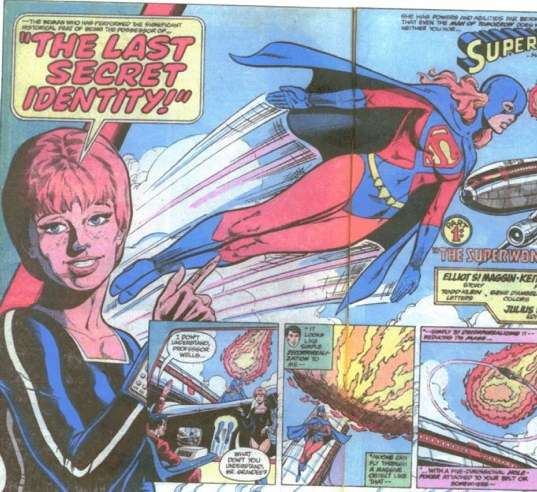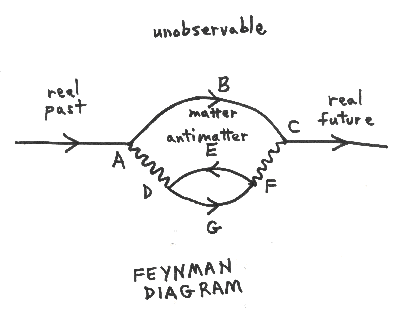
"In the beginning God created ..." (Genesis 1:1) Carmië 8419 FA
!UPER MYTHOS
yrubb orutoo da yreemb
uyon Kryptoniu awyrr
The above is an example of the simplified 26-character Kryptonese used on the "Smallville" TV
series this past season -- "Yrubb orutoo da yreemb uyon Kryptoniu awyrr!" roughly translating as
"He's respectfully acknowledging tomorrow's tragedy by using Kryptonese."
There has however been a much different Kryptonese, what could be called Old Kryptonese,
referred to in the DC Comics over the years, a 118-character version. "Kr" and "pt" in "Krypton",
for example, are written with single characters.
The Superman mythos is much like the Arthurian mythos now with contributions from many
mythopoets over many years. The original Superman was created by a couple Jewish teenagers
in 1934. As Clark, adopted son of John and Mary Kent, he worked at the Cleveland Evening
News and could only leap an eighth of a mile.
The Golden Age (1938-48) Superman was the son of Eben and Sarah (according to George
Lowther) and could fly, then fly faster than light and through time, tunnel through mountains,
vibrate himself invisible, and squeeze diamonds from coal. In 1945 the adventures of Superboy
first appeared.
During the Flux Age (1948-58) Superman's Achilles heel, kryptonite, was revealed. Clark
became the editor of the Daily Star. His parent were Jonathan and Martha.
The most popular Superman however is the so-called Earth-1 Superman, that flourished during
the Silver Age (1959-1970) and the Bronze Age (1972-1986) under the editorship of Mort
Weisinger. In The Last Son of Krypton by Elliot S. Maggin the Kryptonians are explained as a
breeding project by the Guardians of the Universe (like the Doc Smith's Lensman series' Arisians).
"The Krypton Chronicles" (1981) elaborated Kal-El's illustrious ancestors. "The Sword of
Superman" by Cary Bates (Superman Annual # 10, 1984) connected Superman with protecting
not just Earth, but all Creation. Unlike Arthur Pendragon he proves himself by NOT using the
sword.
In the least popular Iron Age (1986-1999) Superman futilely trying to deal with what he could
not do, full of angst and confusion (rather like The Order of the Phoenix Harry Potter). He even
died!
Wisely that age ended and "Return to Krypton" (2001) had Lois and Superman timetravelling
back to pose as the Kryptonian heroes, Flamebird and Nightwing, and try to thwart General Zod's
plot to destroy Krypton.
Even more recently Jon Peters said he wept when he learned the producer's solo Superman
project was a go. "You are going to think I'm crazy," he said, "But I swear I heard the flapping
angel wings when Alan was talking."
===============================================================================
!UPERWOMAN
Readers should be familiar with Superboy and Supergirl, perhaps even the superpets (Krypto
the dog, Streaky the cat, Bleppo the monkey) but have you heard of Superwoman?
Kirsten Wells first appeared in Miracle Monday by Elliot S. Maggin (1981) as a demon-
possessed timetraveling grad student, descendant of Jimmy Olsen. [Miracle Monday, by the
way, is the third Monday in May.] She returned to "Supermanic" times in "The Last Secret
Identity" in which she discovers she is her superheroine, Superwoman!

In "Luthorcon III" she saves Superman's life (since she's immune to kryptonite) and becomes
his companion until she finally remembers how to return home. Later she joined with Robin
(Carrie Kelly), Ms. Flash, Lady Flash, GL #2814 (Diana Kent of Earth-10) and Calico as the
Super Six. The ironic thing about Superwoman is that she's not really superpowered. Her powers
come (like Wonder Woman) from his adornments, a time-space warping amulet and an anti-
gravity belt. (Unfortunately my printer is acting up and I cannot print Superwoman's attractive
red hair against her blue suit.)
~~~~~~~~~~~~~~~~~~~~~~~~~~~~~~~~~~~~~~~~~~~~~~~~~~~~~~~~~~~~~~~~~~~~~~~~~~~~~~
TIMETRAVEL
Time travel, like Superman, Lois and Superwoman, etal., can lead to many interesting stories.
In Charles Williams' Many Dimensions the timetraveller merely re-lived the same 24-hours over
and over, but usually the stories involve branching time lines, like Feynman diagrams.

Suppose a timetraveller travels back in time along the route CFED he/she can then live out an
alternative timeline, DGF. There can however be any number of photonic interactions between
the ABC and the DGF timelines -- visions, dreams, apparitions, mirages. The poor timetraveller
in MD presumably traveled the timeloop CFEDABC several times. Hopefully he gained some
wisdom from having to re-live his past over and over and over again, without being able to change
anything, just what some theorize Purgatory will be like. Hell would be more like re-living over
and over one's own unreality, DGFED.
If we think of Narnia as an alternative timeline from its creation, D, to its final destruction, F, with several connections with our timeline, AC, then Aslan's Country would be a timeless realm outside either, but one in which both those native to DF and to AC can travel to. There is no backward time travel between the two, but there is a time scale difference, so that visitors from our world seem to travel to Narnia's future -- and beyond its futures in the case of The Last Battle. That would be heaven.
TWO TOWERS DVD
We finally got to view the DVD version of "Two Towers". It was better even than the theater version. It was good however to have seen the film itself before seeing how they did it. They used every trick there was and invented new ones. Most valuable of all, however, was seeing how the ones involving in making the film, the trilogy of films, grew into a fellowship themselves. They had adventures making the adventures of the Fellowship. It was good too to hearthe explanations of why they made the changes that they did. There were usually good reasons for them Although we would have preferred an even closer adaptation with the book, this is very likely the best LOTR film trilogy we'll ever see. We have to remember that incredible as it may sound, not everyone who watches the films has read the book, even fewer have it memorized. It was, most importantly, done with a love for the book and if that gets conveyed to the audience, all involved deserve much credit.
The most maddening thing we've heard with reference to the film is that some people see no difference between LOTR and Harry Potter. Yes, both have "wizards" and "magic", but they treat them in vastly different ways. Tolkien's istari were valar (angelic guardians of Middle Earth) "of a sort", sent to counsel the enemies of Sauron. They were centuries old, millenia old, and able weild power through their staffs. Rowling's wizards also come in good and evil versions true, but the "good" ones are very human, using their powers selfishly, arbitrarily, lording it over their appentices. One almost wishes that they would destroy each other.
Harry who is supposedly the best of their lot, is more human that most, driven by male hormones and ego much of the time. Gandalf, like the wise old man archetype he is, is temptation-resistant and self-sacrificing. And he's not the hero of the trilogy in any case. It is the hobbits, Frodo and Samwise, even Seagol in a peculiar way, who are the heroes, who only seem to get into deeper trouble when they use magic. Loyalty, honesty, bravery, fellowship, are shown to be more powerful than magic. Perhaps Harry will learn that before his series is over, that remains to be seen, but this reader won't be looking forward to the next movie version of a Harry Potter book like we did the "Two Towers". We can hardly wait for the six months until "Return of the King" comes, or later when we can see the 10-hours or so of the whole trilogy at one sitting.